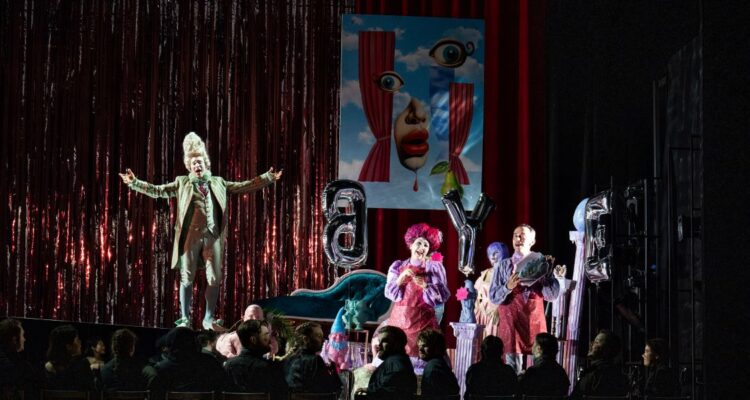English Touring Opera are presenting ‘Manon Lescaut’ and ‘The Rake’s Progress’ this year, beginning their tour in the shabby chic glamour of the Hackney Empire, an appropriate setting for two operas which both depict a journey from riches to rags. Stravinsky’s neo-classical masterpiece of 1951 is a wonderful example of taking elements of tried and tested tradition and recombining them into something wholly distinctive and fresh. Everywhere you look there are sly stylistic and structural references to the great operas of the past – whether by Monteverdi, Mozart, Rossini or Verdi; and yet the whole is never less than entirely authentic Stravinsky. By combining cunning harmonic, ornamental and rhythmic liberties he conveys both astringent, biting satire and tender pathos, all the more affecting for being strictly rationed and filtered through one of the most brilliant and eloquent libretti ever written.
Stravinsky and librettists WH Auden and Chester Kallman take their inspiration from the famous series of engravings by Hogarth which tell the story of the descent from sudden riches to poverty and madness of Tom Rakewell. Naive and gullible, he is fleeced by all and sundry ending up in the Bedlam asylum, deserted by everyone except Ann Trulove, the woman he himself deserted at the start of the action. To the basic story is added Nick Shadow, a witty and sophisticated version of the devil, who stage-manages all the various disastrous temptations. A range of colourful minor characters appear too – Mother Goose, the madam of a brothel; Baba the Turk, a celebrity bearded lady whom Tom marries as a deliberate defiance of convention; Ann’s father, a symbol of conventional morality; and Sellem, who presides over the auction of Tom’s effects. A chorus works hard in assuming a variety of roles in both town and country.
Director Polly Graham faces a particular challenge with this opera, because it has become so closely associated with the famous Glyndebourne production designed in 1975 by David Hockney which drew directly on Hogarth’s originals. While she inevitably references it at points in the costumes, given that this opera pretty much has to have an eighteenth-century setting, she also manages to achieve some original representations of her own that command attention and achieve dramatic conviction. Designer April Dalton provides a slanted and stepped set that reacts flexibly to what is required of it, and the set-pieces, such as the brothel and auction scenes, have the necessary visual surprise and brio, while Bedlam is in many ways a contrasting ironic haven of peace and repose. There are some oddities: it is not clear to me why Ann disguised herself as a knight, with chainmail and sword, channelling Monty Python more than Mozart; and replacing Baba’s sensible sedan chair with a full-size imitation horse was a (literally) clunky device.
On the musical side things were really very fine indeed despite the fact that Fredrick Jones, as Tom, sang only the first act before handing over to his cover, Brenton Spiteri. Coordination between Jones onstage and Spiteri in the wings and the conductor Jack Sheen,was outstanding; so that what could have become a disabling problem quickly faded into the background to the great credit of all involved. Spiteri in particular shone out with burnished tone, verbal dexterity and an incisive sense of rhythm. Jerome Knox, as Shadow, offered seductive charm and mischief rather than menace, in line with the deliberately collusive, light touch of composer and librettists in handling evil. He was an elegant master of ceremonies, as was Robin Bailey as Sellem, bedecked in a toppling perruque. Nazan Fikret was very convincing as Ann Trulove singing with purity and personality, and nailing the top C of her first aria with precision. Innocence and kindness need to stand out with presence against the glittering, deceptive surfaces all around, and she ensured that vital balance was in place, assisted with the sober gravity of Trevor Eliot Bowles as her father. Amy J Payne made the most of Mother Goose’s all-too-brief appearances and a costume that contained surprises worthy of Bunuel or Dali. The singing that gave the greatest pleasure, however, was Lauren Young’s take on Baba the Turk, which fully uncovered the humanity and grace of a character-role too often played for cheap laughs or spluttering rage.
The orchestra played with great taste and discernment in a score where the mood and tempo needs to change on a sixpence. I peered into the pit during the interval, and noticed that all the markings on the parts related to rhythm and pointing. This is so right as an embodiment of Stravinskey’s watchword that ‘pulsation is the reality of music.’ Conductor Jack Sheen found that pulse, to be sure, on press night.
This opera is an excellent choice for young singers who can act well. It suits the fearless vim and vigour of a young cast who here deliver an invigorating set of performances that should give great pleasure on the current tour.
Venue: Hackney Empire
Director: Polly Graham
Photo credit: Richard Hubert Smith
Until 28th May 2024 (on tour)
2 hrs 40 mins, with interval

